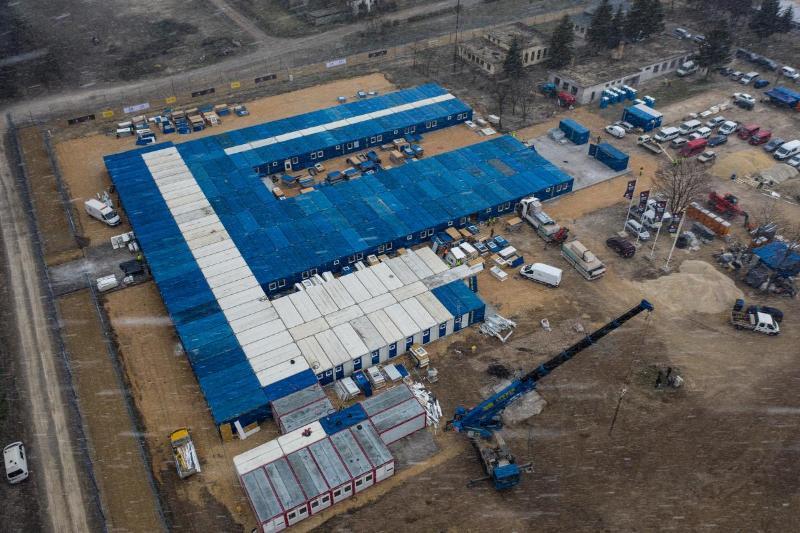In a field that’s usually high-tech and innovative, 2020 saw health authorities across Europe scramble to finance basic medical supplies, while others looked for simple solutions for COVID-19 infection spikes
The city of Kiskunhalas in southern Hungary saw that its COVID-19 infection rate could become too hard for the area’s health services to control this March, so the government decided to put up a mobile hospital.
“It was built in just a few weeks to respond to a surge in the number of hospitalised cases in the area,” says Gabor Kiss, a European Investment Bank loan officer who worked on the financing for Kiskunhalas and other emergency COVID-19 medical supplies in Hungary.
The Kiskunhalas Epidemic Mobile Hospital has a capacity of 150 patients and is specifically designed to treat those suffering from COVID-19 who need intensive care. “It also helps contain the virus,” emphasises Tunde Szabo, the Bank’s health economist. “The local health service are able to separate coronavirus patients from other patients, thus substantially reducing the risk of hospital-acquired COVID-19 infections.”
The European Investment Bank typically supports medical innovation, from financing hospital infrastructure to medical devices, biotechnological innovation, and the development of COVID-19 vaccines. But, in a year unlike any other, it was not innovative technology and tools that hospitals and healthcare workers all over the world lacked most, especially in the first months of the pandemic. Rather, governments struggled to provide essential equipment to prevent the spread of the disease, as well as infrastructure and staff to treat severe SARS-Cov-2 cases. So they came to the European Investment Bank with requests to finance much more basic medical needs than usual.

Kiskunhalas Epidemic Mobile Hospital
Countries had to react swiftly to supply their hospitals and health centres with essential protective equipment, including medical masks, gloves, sanitising products, and equipment needed specifically for SARS-Cov-2-related critical care, such as intensive care beds and respiratory equipment.
In March 2020, even though Hungary was not among the worst hit EU countries, the government still needed to protect the health of its population by stemming the infection rate. It also had to prepare for a possible second wave of infections. This proved crucial as Hungary was hit especially hard later in the year.
To help the country finance its emergency response, the European Investment Bank stepped in with a €162.5 million loan to the Hungarian government. It financed almost 500 different types of items required by the healthcare sector to avoid the spread of the disease and to treat patients efficiently.
“This was a special healthcare project for the Bank,” says the Bank’s Szabo. “Our projects usually involve hospital modernisation and health innovation, but these are extraordinary times. Recognizing the urgent need, we had to respond quickly to support the EU member states and help them deal with the coronavirus crisis in whatever way we could.”
Respirators, disinfectants, masks, ventilators, patient monitors. These are just some of the items the Hungarian government secured through this loan. “Nearly the entire loan went to medical equipment and supplies required for the day to day operation of health centres during a pandemic,” Szabo says.
The newly purchased medical equipment was distributed throughout Hungary.
Simple solutions for COVID-19 in Czech hospital project
The Hungarian crisis response is one of many COVID-19-related projects the EIB supported in the past year. The number of healthcare projects at the Bank tripled, compared to the previous year. The Bank’s 2020 health sector projects, however, were not solely focused on emergency response. Despite the unprecedented circumstances, we didn’t forget about our long-term healthcare infrastructure goals.
The coronavirus crisis has stretched local health services to their limits. The pandemic has also exposed their vulnerabilities and lack of preparedness. Inadequacies at older hospitals have been put under the spotlight, pushing local governments to address them.
This is why the EIB is supporting the Central Bohemian Region in the Czech Republic with a €48 million loan to improve its emergency preparedness and modernise its healthcare, transport, social care and education infrastructure.
More than half the money will go to the refurbishment and modernisation of five hospitals in the region, as well as the Central Bohemia ambulance service. The investment will result in almost 1.4 million people in the region having better access to improved health services. “The programme will enable these medical facilities to become more efficient, increase the quality of their services and contribute to energy efficiency and emergency preparedness,” says Szabo.
It’s not about increasing the number of hospital beds. Rather, it is about increasing the resilience of our hospitals.
The best time to prevent the next pandemic
“The way to deal with a pandemic is to improve our existing health facilities,” Szabo explains. “It’s not about increasing the number of hospital beds. Rather, it is about increasing the resilience of our hospitals.” This can be done with simple solutions such as improving ventilation systems to reduce hospital-acquired infections, and that’s one of the changes made in the Czech Republic hospitals.
“It is also about rethinking our healthcare system,” Szabo points out. “We need to increase the number of chronic care centres. Chronic care should not be provided in acute hospitals, because it is the most resource-consuming form of care. Purpose-built chronic care facilities are much more efficient and are easier to adapt for infection control.”
The coronavirus pandemic has forced us to speed up these developments – to rethink our hospitals and evaluate how prepared we actually are. As we have all come to understand this year, the best time to prevent the next pandemic is now.
